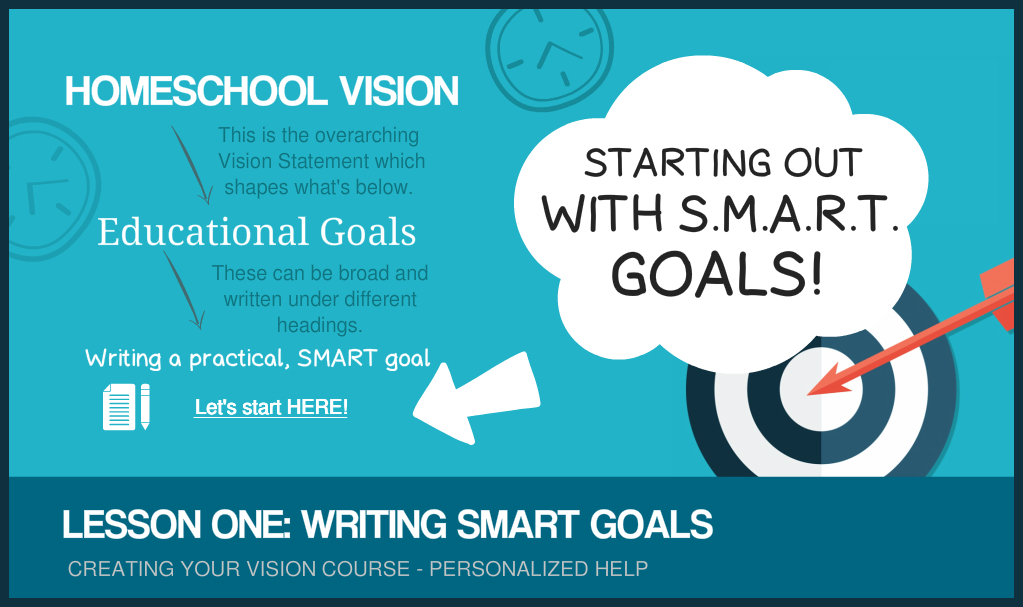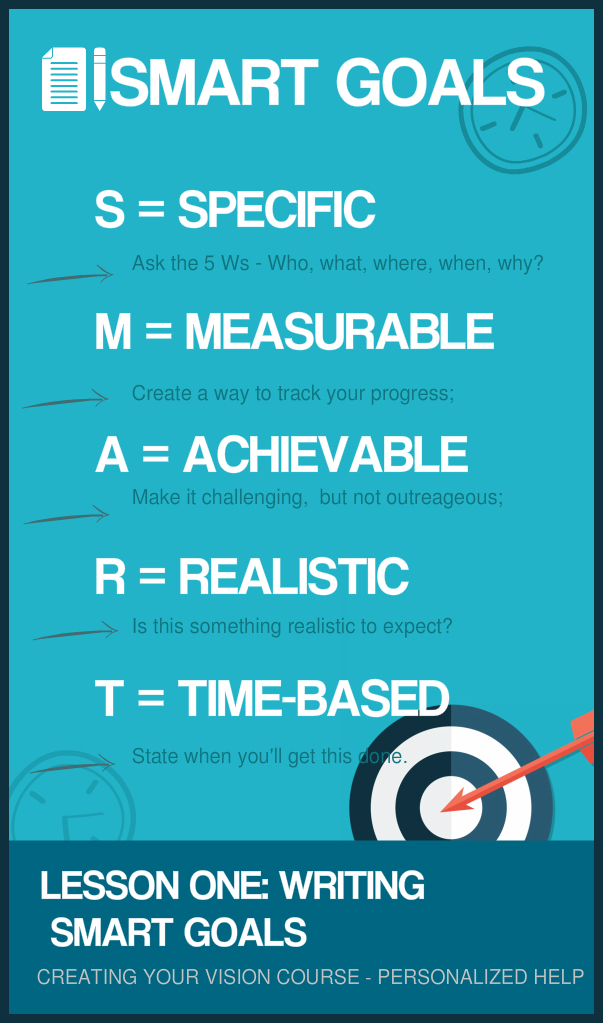Create your Homeschool Vision Course - Lesson One
You've got to know where you are going

I'm not sure if you're a fan of 'mystery holidays' - where you sign up, pay your money and hope for the best. When you take a holiday like that, you don't actually know where you're going. You don't know if the hotel they have picked for you will be AWESOME!! or just mediocre...
You don't know if the location you're going to will be somewhere you've been before ( ho, hum...) or somewhere you had your heart set on.
Are you that type of person? Someone who happy to go for the ride and take things as they come or are you keen to have a plan in mind?
I have a feeling, that if you're reading this - that you like to know where you're heading. And, to be honest, that's me as well.
It might be fun to be surprised (as far as a mystery holiday goes) but at the same time - you might be seriously disappointed.
In any case, writing a goal (large or small) is a way in which you drive towards something. It's true, we don't always meet our goals (like losing weight, or keeping a good habit going...) but at least we strive for it - we work at it - we try to keep it at the forefront of our minds and face it as a worthwhile challenge.
A homeschool vision sounds "BIG" so let's step back first!

Creating your homeschool vision may sound really daunting! And some of you may be wondering right now - "Can I really do this?"
Well, let me assure you that you can and you will!
By the end of the Homeschool Vision Course - you will have an Action Plan! It will contain short and long term goals for your homeschool all underneath the framework of a Vision Statement.
But, just to get you started in the whole goal setting mentality, this lesson is going to be about setting smaller, short term goals you'll actually be able to check off.
We're going to set a SMART goal - something Specific, Measurable, Achievable, Realistic and Time-managed.
Lesson 1: Let's start specific and set one SMART goal
On my page on setting family homeschool goals, I wrote about goal setting across 3 different areas: Relationship, Practical and Academic goals. We're going to go into these specific goals and how to set them in far more detail later on in the course. However, for this exercise - let's focus on one goal and today I've picked a relationship goal - developing the character trait of industriousness.
Example of goal setting: Industriousness

Let's say that one of the goals you would like to set for your child is that they are an industrious worker. You could pick another character trait such as: being attentive, generous, obedient, orderly - but for this exercise, we'll pick being 'industrious.'
Some other words to describe being industrious can be:
Assiduousness, diligence, application, zealousness, laboriousness, indefatigability (try dividing that into syllables!), ready for action, busy bee, energetic... get the idea?
To set a SMART goal, we need to really focus down to what we mean and then work out a way that it becomes specific and achievable - something we can measure and tick off.
- S = Specific
- M = Measurable
- A = Achievable
- R = Realistic
- T = Time-based
What does "industriousness" look like?
So, when we write a goal that says we want our child to be industrious - what is a way in which we can phrase that goal so that it contains action points you can tick off at some point?
If we write, "I want my child to be industrious" we could be tempted to add a ton of books to their workload, so we can look at the pile - and feel like we've helped them to be industrious. We could micro manage their day, their hours, their minutes with all sorts of things - excursions, classes, projects etc - so they (and you) fall into bed exhausted feeling like they were industrious.
But, that's just missing the point. What do we really want from them and how can we carefully work towards that goal?
Firstly, we need to work out exactly what we are talking about. It's okay to just write out a bunch of goals of good virtues and character traits, but it's not all that helpful until we make them specific. In order to make them specific, we really need to work out what we're talking about. This is what being industrious means (and doesn't mean) to me:
- Being industrious does not mean "just being busy" for the sake of busyness. We don't want to fill our children's day with fill-in worksheet for no reason. I urge you to look at what you are using and question - is this making the learning meaningful or am I filling in time? It isn't necessary to fill in each worksheet in a workbook just because it's there. Skip pages if they understand the concept; do exercises orally; don't work through a book for no valid reason. Keep all their learning real, -focused and purposeful. Being industrious does not mean we're keeping our kids 'busy' for the sake of 'busyness.'
- Being industrious also means we should use all our time wisely. We need to use the time in the car to sing songs, memory chants, math facts - tables etc, Bible verses, and conversation. Talk about everything when you are in the shops, while walking, while working - as it says in Deuteronomy 6: "as you rise, when you lie down, as you walk along the road..."
- We also need to make decisions as to what is worthwhile in regards to our time - what to pursue, what to leave, what excursions to go on, what to leave out... when to do it... Remember to keep your focus and enjoy your time at home without being 'busy' chasing the "must-do-activities."
- Lastly, as we apply the goal of industriousness in our family, we should measure the things we do by the benefit it gives others. Are the things we are involved in useful to others? Think of projects that are useful for the home, that build others up and are for the enjoyment of others. We should also take into consideration the needs of the whole family.
Create a SMART goal on industriousness
So, let's say you've decided that you want your child to be focused on their work and not waste time. I know that I have often needed to set that goal as some of my kids were prone to gaze out of the window and then get a huge shock when they were brought back to reality!
So, depending on the age of the child, your goal could be:
- To give full attention to "this task (math lesson/ reading quietly / playing alone / writing)...............fill in the blank" for 20 minutes 3X per week for 2 months;
Now let's check to see if it is SMART:
Firstly, once we have added in the subject area or area of life we're working on- this goal can be really specific. They may need to focus on reading quietly without wasting time, interrupting others, going to the toilet, and being distracted. If that's the issue - set the goal to be "give full attention to reading quietly on my own for 20 minutes, 3 X per week."
It is also measurable - as we have added in the time and how often we are going to measure it - 3 times per week.
It's easy to see how this goal can be achievable, but if it doesn't make sense in your situation, - then you need to decrease the time or the frequency to make sense for your child and for their particular circumstances. Charlotte Mason, an advocate of short lessons would never let children dawdle over a subject - but would recommend that the child concentrates fully on a subject for a shorter period of time rather than allowing them to dawdle and in so doing, learn to be inattentive.
Again, if it's something way above what they are currently able to do - you may need to adjust it to be something which is realistic - something they can strive towards without feeling defeated before they've even begun.
And lastly, it is time-based, as we've given it a time frame to develop this habit.
This might seem like a long winded process to set a goal, but in actual fact it's just a sentence which is carefully constructed so that you can measure and mark things off. It will also be very helpful to your child so they know exactly what the focus and achievable goal is. (It might even involve rewards??!)
How to break the goal into practical steps
To break this down into practical steps, it would be good to display the goal - and have it printed out. If it is going to be a family goal - it could be displayed wherever you meet at the beginning of your day (morning time would be a perfect time to discuss, share progress, recite related Bible verses). If it is a specific goal for one child - then print it and have it right above where they mostly do their work.
To make it measurable - you can create a simple checklist with the goal at the top and a place to record the daily progress of achieving the 20 minute focused attention. Each time, they achieve the goal, they can receive a sticker as a reward and work towards a prize!
If you have a few children, it would make perfect sense to work on a character goal such as "Industriousness" altogether as a family. By doing this, you can keep a check on each other, memorize Bible verses specific to the character trait, read stories which exemplify this trait and develop specific goals or fun activities based around working on this goal.
A perfect start to working through character together is "Our Family Ways" by Diana Waring. This book helps the family to concentrate on character using Bible verses, Bible stories and pages to print, colour and display as a reminder.
How would I help my child to achieve this goal?
Our goal is to help our children achieve goals and work to improve their character and skills, so when we set a goal, we want to give them a way forward to work towards it.
What can we do to help make this goal achievable?
- Print it out and keep it visible;
- Set a timer to keep focused attention for the duration of the time;
- Provide the reward of free time when the goal is met each day;
- Keep a reward chart marking off each time the goal is met;
Lesson 1: Write a SMART goal - Flip Book
Feel free to download this lesson as an e-book, print it and fill in the Action Step on the last page. How did you go?
Do you have any other suggestions?
This lesson was specifically written to show you how to set a specific goal and how this can be useful in the practical day to day homeschool life. We're planning on setting more specific goals as well as going way up high to the top of the goal list - and creating your own homeschool vision.
By creating your homeschool vision, you are setting out to have a plan and with this is an overarching mindset, it's going to be far easier to set the nitty gritty homeschool goals.
Creating your own Action Plan with short and long term goals for your family is going to be incredibly helpful step at any stage of your homeschooling journey!
It will be great if you're just starting out - and if you're coming to the end, it may just be what you need to keep your attention for the home-run.
If you have any further feedback, before I open up the Course - please head back to this page and let me know your two TOP questions about creating a Homeschool Vision - that we absolutely need to answer in our course.
